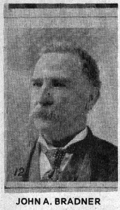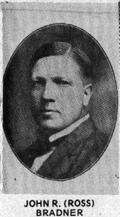December 10, 1981


Picture #1 – John A. Bradner
Picture #2 – John R. (Ross) Bradner
It is strange, and it seemed almost impossible, that a man who was prominent in Fostoria and northwestern Ohio from 1863 to 1901, would not have left a photograph of himself…not even one in a family album. But, that seemed to be the case of John A. Bradner, grandfather of Fostorian Harry R. Bradner, 1019 Lincoln…until, your author finally discovered one in The Railway Reflector, published by The Columbus, Hocking Valley & Toledo Railway Co., issue of January 1897.
Also unusual is the lack of acclaim and eulogy in the newspapers of that time for the many achievements of John A. Bradner…except in the Centennial Biographical History of Northwestern Ohio, from which information for this article is excerpted. That history perhaps held the key to the mystery of his low-key public profile, and why he could function so effectively without acclaim:
“By the death of John A. Bradner, Fostoria and Seneca County, and, indeed, the state of Ohio, sustained an irreparable loss and were deprived of the presence of one who had come to be looked upon as a guardian and friend. By his usefulness and general benevolence he created a memory whose perpetuation does not depend upon sculptured stone or elaborate mortuary crypt, but rather upon the spontaneous and free will offering of a grateful and enlightened people”.
Bradner’s family was of Scotch lineage, and was founded in America by his grandfather who was a native of Scotland, and a Presbyterian minister. John A. was born Aug. 13, 1833, at Niagara Falls, N.Y., son of William and Laura (Everingham) Bradner. He spent his early life there and was educated at Lewiston Academy.
In 1849, he moved with his parents to Perry Township, Wood County, Ohio, where his father established a store at West Millgrove. After working as a clerk in his father’s store for six years he bought and operated it for two years.
On March 3, 1856, he was united in marriage to Miss Catherine Phillips, daughter of Samuel and Sarah Phillips of Jerry City, Ohio, and unto them were born eight children, five girls, Catherine, May, Rosa, Jessie, Franc; and three boys, Martin, Harry E. and John R.
In 1859, he moved to Fremont, where he was manager of a warehouse for four years. In 1863, he arrived in Fostoria, establishing a hardware and stove business, in which he was engaged for nine years, until 1872. At that time other demands were being made for his time in other endeavors, so he disposed of that store.
The next 30years of John A. Bradner’s life was devoted to railroad building. He aided in securing the right-of-way, and was engaged in the construction of the Hocking Valley, the Ohio Central and the Nickel Plate railroads.
The Hocking Valley eventually became part of the Chesapeake & Ohio, today known as the Chessie System. The Ohio Central in later years became part of the New York Central, and still later The Pennsylvania System…no longer.
Bradner also took the contract for the construction of 19 miles of the old Manfield, Coldwater & Lake Michigan Railroad; also 35 miles of the Clover Leaf Railroad.
He also secured the right-of-way for the Toledo, Fostoria – Findlay electric railroad, and at the time of his death he was the secretary and treasurer and general manager of the Ohio & Northwestern electric railroad.
Bradner macadamized the principal streets of Fostoria. He was also engaged in the stone and lime business, having been a large stockholder and president of the Fostoria Stone & Lime Co. He was one of the organizers of the first gas company in Fostoria.
When he was engaged in building the Hocking Valley Railroad, Bradner was associated with Mr. Ransom Crocker in the founding and planting of a town in Wood County, located on the line of that railroad. The town became prosperous, being located in the center of the oil belt of that era.
In addition to all his other interests, John A. Bradner studied law, was admitted to the bar in 1879, and became the first city solicitor of Fostoria. For 20 years, he was incumbent of the office of justice of the peace, serving for seven consecutive terms in that office in Loudon Township. For six years he was the mayor of Fostoria.
Though he had no personal political ambition, Bradner was a stalwart Republican.
His religious faith was that of the Presbyterian Church.
In the winter of 1900-1901, when he was involved with work on the right-of- way for the electric line from Fostoria to Jerry City, he took ill. He died July 9, 1901.
The Centennial Biographical History sketch finally described John A. Bradner:
“He was a man remarkable in the breadth of his wisdom, in his indomitable perseverance and in his strong individuality…A man of indefatigable enterprise and fertility of resource, he carved his name deeply on the records of the industrial and professional history of his section of the great state of Ohio, which owes much of its advancement to his labors”.
In regard to John A. Bradner’s sons, they all turned in good records for their business careers:
Martin was editor of the Evening News in Fostoria.
John R. (Ross), father of Fostorian Harry R. Bradner, was active in real estate, insurance and a collection agency. He also served as justice of the peace for Loudon Township. He was also a constable and justice of the peace for two terms.
Harry E. took up the study of law in the office and under the direction of Charles A. Strauch in Fostoria. However, he did not practice law, but became interested in the City Heat & Light Co. of which he was made secretary and treasurer, and later elected its president. After serving his connection with City Heat & Light, he became interested in journalism and published a paper at Tiffin, Ohio, later one at Marion, and at the time of his death, was the editor and proprietor of the Fairfield County Gazette, at Lancaster, Ohio.
The other children of John R. (Ross) Bradner, besides H.R. (Harry) were: Alonzo, surviving, Cleveland; Earl Milton, deceased; Virgil Charles, deceased; LeRoy Jesse, deceased; Catherine Cook, surviving, Toledo; Edgar Curtis, surviving, Toledo; Florence, deceased; Peri Corelli, surviving, Canton; two sons, Charles and Max, died in infancy.